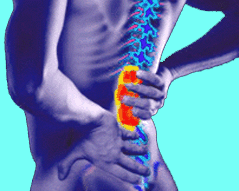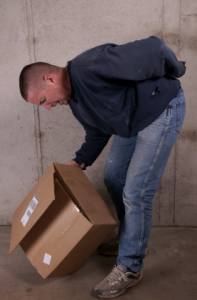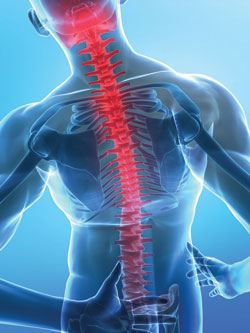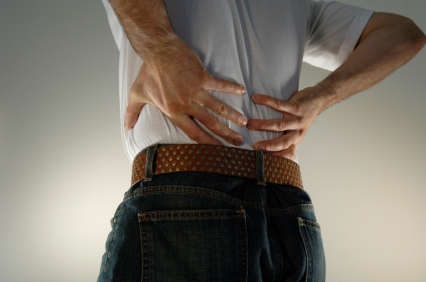 Preventing back injuries is a major workplace safety challenge. According to the Bureau of Labor Statistics, more than one million workers suffer back injuries each year, and back injuries account for one of every five workplace injuries or illnesses. Further, one-fourth of all compensation indemnity claims involve back injuries, costing industry billions of dollars on top of the pain and suffering borne by employees.
Preventing back injuries is a major workplace safety challenge. According to the Bureau of Labor Statistics, more than one million workers suffer back injuries each year, and back injuries account for one of every five workplace injuries or illnesses. Further, one-fourth of all compensation indemnity claims involve back injuries, costing industry billions of dollars on top of the pain and suffering borne by employees.
Tag: back injury
Back Injury and Back Pain
 Back symptoms are among the top ten reasons for medical visits. For 5% to 10% of patients, the back pain becomes chronic.
Back symptoms are among the top ten reasons for medical visits. For 5% to 10% of patients, the back pain becomes chronic.
- In 2001, the Bureau of Labor Statistics reported 372,683 back injury cases involving days away from work. Most cases involved workers who were aged 25–54 (79%), male (64%), and white, non-Hispanic (70%)
- Two occupational groups accounted for more than 54% of back injury cases: operators, fabricators, and laborers (38%); and precision production, craft, and repair (17%)
Data from scientific studies of primary and secondary interventions indicate that low back pain can be reduced by:
- Engineering controls (e.g., ergonomic workplace redesign)
- Administrative controls (specifically, adjusting work schedules and workloads)
- Programs designed to modify individual factors, such as employee exercise
- Combinations of these approaches
via CDC – Workplace Health – Implementation – Work-Related Musculoskeletal Disorders (WMSD) Prevention.
Back Injuries and Workers’ Comp
 Back injuries have a bad reputation. “The workman looks upon them with apprehension, the insurance company with doubt, the medical examiner with suspicion, the lawyer with uncertainty, and the court with as open a mind as is possible under the circumstances….”
Back injuries have a bad reputation. “The workman looks upon them with apprehension, the insurance company with doubt, the medical examiner with suspicion, the lawyer with uncertainty, and the court with as open a mind as is possible under the circumstances….”
This statement was written in 1917. Not much has changed since then.
Back Injuries
 Your back is made of bones, muscles, and other tissues extending from your neck to your pelvis. Back injuries can result from sports injuries, work around the house or in the garden, or a sudden jolt such as a car accident. The lower back is the most common site of back injuries and back pain. Common back injuries include:
Your back is made of bones, muscles, and other tissues extending from your neck to your pelvis. Back injuries can result from sports injuries, work around the house or in the garden, or a sudden jolt such as a car accident. The lower back is the most common site of back injuries and back pain. Common back injuries include:
- Sprains and strains
- Herniated disks
- Fractured vertebrae
These injuries can cause pain and limit your movement. Treatments vary but might include medicines, icing, bed rest, physical therapy, or surgery. You might be able to prevent some back injuries by maintaining a healthy weight, lifting objects with your legs, and using lower-back support when you sit.
Back Injuries
 Strained muscles and sprained ligaments are the most common causes of back pain. This type of back pain, which lasts less than three months, is considered to be “acute”. With proper treatment these injuries usually heal within a few weeks.
Strained muscles and sprained ligaments are the most common causes of back pain. This type of back pain, which lasts less than three months, is considered to be “acute”. With proper treatment these injuries usually heal within a few weeks.
When back pain persists or frequently reoccurs, it is considered to be “chronic”. Chronic back pain may indicate that something is wrong with the spine itself.
Several factors may increase the onset of acute or chronic back pain including:
- Lifting incorrectly
- Carrying objects incorrectly
- Pushing or pulling heavy objects
- Frequent back bending
- Poor posture
- Being overweight
- Lack of physical fitness
- Inadequate tools
- Environmental barriers
Talk with your doctor if you are experiencing either acute or chronic back pain.
via Back safety – Environment, Health & Safety – University of Wisconsin System.
Stay Safe at Work
 If work isn’t performed safely, it can put a lot of wear and tear on your body. Back injuries are the most common type of workplace injury.
If work isn’t performed safely, it can put a lot of wear and tear on your body. Back injuries are the most common type of workplace injury.
Make simple changes to prevent injuries and stay healthy:
- Lift things safely.
- Arrange your equipment to fit your body.
- Take short breaks and stretch your muscles.
- Eat a healthy diet and stay active.
- Watch your weight.
- Get enough sleep.
via Workplace Safety.
Herniated Disc-What Increases Your Risk
 There are various risk factors for a herniated disc.
There are various risk factors for a herniated disc.
There are some risk factors you cannot change. But if you know about them, you can be prepared to consider how they will affect you. These include:
- Advancing age. The process of aging of the discs in the lower back, as well as repeated injury to the discs and spinal muscles, makes a person more likely to have low back problems, which usually begin in midlife.
- Being male.
- History of back injury, previous herniated disc, or back surgery.
Some risk factors you can change, with lifestyle changes or medical treatment. If you take steps to limit the risks from these factors, you can decrease your overall risk of having a herniated disc. Risk factors you can change include:
- Your job or other activities that increase the risk of developing a herniated disc, such as long periods of sitting, lifting or pulling heavy objects, frequent bending or twisting of the back, heavy physical exertion, repetitive motions, or exposure to constant vibration (such as driving).
- Not exercising regularly, doing strenuous exercise for a long time, or starting to exercise too strenuously after a long period of inactivity.
- Smoking. Nicotine and other toxins from smoking can keep spinal discs from absorbing all the nutrients they need from the blood, making disc injury more likely. Smoking also increases your sensitivity to pain. For information on how to quit smoking, see the topic Quitting Smoking.
- Being overweight. Carrying extra body weight (especially in the stomach area) may put additional strain on the lower back, although this has not been proven. But being overweight often also means being in poor physical condition, with weaker muscles and less flexibility. These can lead to low back pain. For information on how to maintain a healthy weight, see the topic Weight Management.
Lift properly to prevent back injury
 No one is immune to back injury. Whether you have a strong back or have hurt your back before, it is well worth it to:
No one is immune to back injury. Whether you have a strong back or have hurt your back before, it is well worth it to:
- Stop yourself before casually picking up a light or heavy load.
- Plan in your mind for the best way to lift what’s in front of you. This could include enlisting help from one or more people.
- Lift and move slowly and carefully.
The time you take to use the right lifting mechanics is far less than the days, weeks, or months it can take to heal from a back injury.
